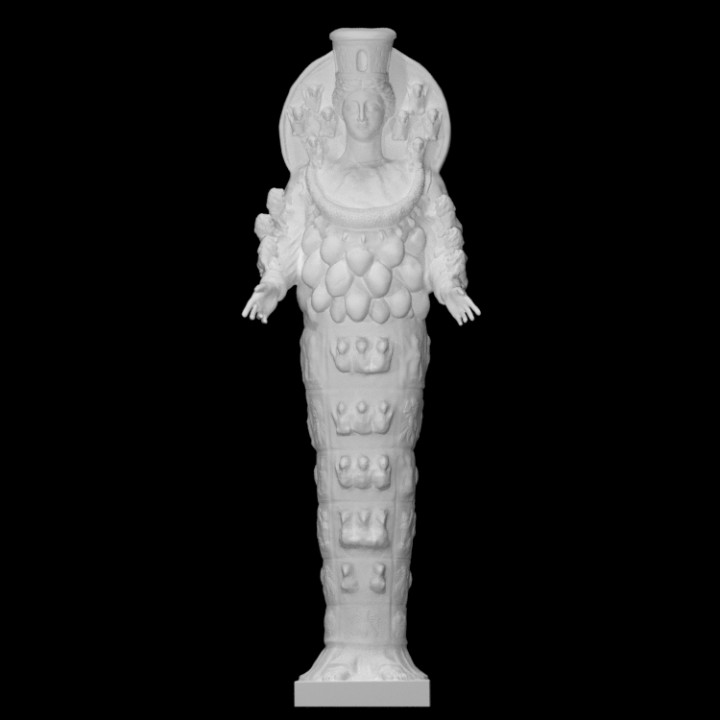
Artemis of Ephesus
myminifactory
From a Greek perspective, Ephesian Artemis takes on a unique form as their goddess Artemis. In Greek mythology and cult, Artemis is the twin sister of Apollo, a virgin huntress who supplanted Selene as the goddess of the Moon. At Ephesus, a goddess associated with Artemis was venerated in an ancient, pre-Hellenic cult image carved from wood and adorned with jewelry. Robert Fleischer identified the changeable features on the primitive xoanon as decorations that had been misinterpreted since Minucius Felix and Jerome's attacks on pagan popular religion. These features were seen as many breasts or "eggs," symbolizing her fertility. Others believed they represented the testicles of sacrificed bulls, which would have been hung on the image with similar meaning. Similar to Near-Eastern and Egyptian deities, the Lady of Ephesus had a body and legs enclosed within a tapering pillar-like structure, from which her feet protruded. On coins minted at Ephesus, she wore a mural crown, an attribute of Cybele, and rested one arm on a staff formed by entwined serpents or a stack of ouroboroi, the eternal serpent with its tail in its mouth. Both the Lady of Ephesus and Cybele were served by temple holy women, called hierodules, under the direction of a priestess who inherited her role. They were also attended by a college of eunuch priests known as "Megabyzoi" and young virgins, or korai. The "eggs" or "breasts" of the Lady of Ephesus are now believed to be descendants of amber gourd-shaped drops, elliptical in cross-section and drilled for hanging. These objects were rediscovered in excavations from 1987-88 and remained in situ where the ancient wooden cult figure had been caught by an 8th-century flood. A hypothesis offered by Gerard Seiterle that these objects represented bulls' scrotal sacs cannot be maintained. A votive inscription, mentioned by Florence Mary Bennett, dates to around the 3rd century BC and associates Ephesian Artemis with Crete: "To the Healer of diseases, to Apollo, Giver of Light to mortals, Eutyches has set up in votive offering [a statue of] the Cretan Lady of Ephesus, the Light-Bearer." Greek habits of syncretism assimilated foreign gods under some form of their Olympian pantheon. At Ephesus, the identification with Artemis made by Ionian settlers was slender. The Christian approach was at variance with the tolerant syncretistic approach of pagans to gods who were not theirs. A Christian inscription at Ephesus suggests why so little remains at the site: "Destroying the delusive image of the demon Artemis, Demeas has erected this symbol of Truth, the God that drives away idols, and the Cross of priests, deathless and victorious sign of Christ." The assertion that the Ephesians believed their cult image fell from the sky is only known at Ephesus from Acts 19:35. Lynn LiDonnici notes that modern scholars are likely to be more concerned with the origins of the Lady of Ephesus and her iconology than her adherents were at any point in time. The Temple of Artemis or Artemision, also known as the Temple of Diana, was a Greek temple dedicated to the goddess Artemis. It was located in Ephesus, near the modern town of Selçuk in present-day Turkey. One of the Seven Wonders of the Ancient World, it was completely rebuilt three times before its final destruction in 401 AD. Only foundations and sculptural fragments of the latest temple at the site remain.
With this file you will be able to print Artemis of Ephesus with your 3D printer. Click on the button and save the file on your computer to work, edit or customize your design. You can also find more 3D designs for printers on Artemis of Ephesus.
